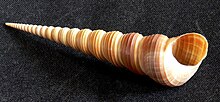Turritellidae
| Turritellidae | |
|---|---|

| |
| A shell of a Turritella species | |
| Scientific classification | |
| Kingdom: | |
| Phylum: | |
| Class: | |
| (unranked): | |
| Superfamily: | |
| Family: | Turritellidae Lovén, 1847
|
| Diversity[1] | |
| 125 extant species | |
Turritellidae, the tower snails, is a taxonomic family of small to medium-sized sea snails, marine gastropod molluscs in the clade Sorbeoconcha.
These snails are filter feeders. This method of feeding is somewhat unusual among gastropod mollusks, but is very common in bivalves.
Shell description
The shells of turritellid species have whorls that are more convex and an aperture which is more circular than it is in the auger shells which are similarly high-spired. The columella is curved and the thin operculum is horny.
Anatomy of the soft parts
These snails burrow into mud or sand. The foot is relatively small.

Taxonomy
The following five subfamilies were recognized in the taxonomy of Bouchet & Rocroi (2005):
- Turritellinae Lovén, 1847 - synonyms: Zariinae Gray, 1850; Zeacolpini Marwick, 1971; Archimediellidae Starobogatov, 1982; Tachyrhynchinae Golikov, 1986
- Orectospirinae Habe, 1955
- Pareorinae Finlay & Marwick, 1937
- Protominae Marwick, 1957
- Vermiculariinae Dall, 1913 - synonym: Pseudomesaliidae mahmoud, 1955 (inv.)
Genera
Genera within the family Turritellidae include:
Turritellinae
- Archimediella Sacco, 1895
- Banzarecolpus Powell, 1957
- Colpospira Donald, 1900
- Gazameda Iredale, 1924
- Glyptozaria Iredale, 1924
- Incatella DeVries, 2007[2]
- Maoricolpus Finlay, 1927
- Neohaustator Otuka, 1934
- Spirocolpus Finlay, 1927
- Stiracolpus Finlay, 1926
- Tachyrhynchus Mörch, 1868
- Turritella Lamarck, 1799 - the type genus of the family, synonyms: Torcula Gray, 1847; Proto Blainville, 1824
- Zeacolpus Finlay, 1927
- Zaria Gray, 1842
Orectospirinae
- Orectospira Dall, 1925
Pareorinae
Protominae
- Protoma Baird, 1870 - synonym: Protomella Thiele, 1929
Vermiculariinae
- Vermicularia Lamarck, 1799
Palaeontological locations

- The Turritellenplatte of Ermingen ("Erminger Turritellenplatte" near Ulm, Germany) is situated in the northern part of the North Alpine Foreland Basin (NAFB) and is famous for its abundance of Turritella turris gastropod shells within sedimentary deposits. The fauna of this gastropod-rich sandstone reflects mainly near-coastal and shallow marine conditions.[4] Petrographical and palaeontological data allow a correlation of Turritellenplatte of Ermingen with Burdigalian (Lower Miocene). Sr-isotope composition of shark teeth suggests an age of about 18,5 Ma for the Turritellenplatte of Ermingen.[5]
References
- ^ Strong E. E., Colgan D. J., Healy J. M., Lydeard C., Ponder W. F. & Glaubrecht M. (2011). "Phylogeny of the gastropod superfamily Cerithioidea using morphology and molecules". Zoological Journal of the Linnean Society 162(1): 43-89. doi:10.1111/j.1096-3642.2010.00670.x.
- ^ DeVries T. J. (2007). "Cenozoic Turritellidae (Gastropoda) from southern Peru". Journal of Paleontology 81(2): 331-351. doi:10.1666/0022-3360(2007)81[331:CTGFSP2.0.CO;2].
- ^ Harzhauser M. (2007). "Oligocene and Aquitanian gastropod faunas from the Sultanate of Oman and their biogeographic implications for the western Indo-Pacific". Palaeontographica Abteilung A 280: 75-121. PDF.
- ^ Baier J. (2008). "Über die Tertiärbildungen im Ulmer Raum". Documenta Naturae 168: 1-32. München. ISBN 978-3-86544-168-3.
- ^ Baier J. (2008). "Ein Beitrag zur Erminger Turritellenplatte (Mittlere Schwäbische Alb, SW-Deutschland)". Jahresbericht Mitt. oberrhein. geol. Ver., N.F. 90: 9-17. Stuttgart, ISSN 0078-2947.
Further reading
- Mayr H. (1985). A Guide to Fossils. Princeton University Press, Princeton, New Jersey, USA. (English translation 1992).
- Powell A. W. B. (1979). New Zealand Mollusca, William Collins Publishers Ltd, Auckland, New Zealand, ISBN 0-00-216906-1.
External links
- "Turritellidae". Integrated Taxonomic Information System.
- Selachian fauna of Turritellenplatte: Abstract of Baier et al. 2004
- Age and Sedimentpetrography of Turritellenplatte: Abstract of Baier 2008
- Turritelidae species database
